|
|
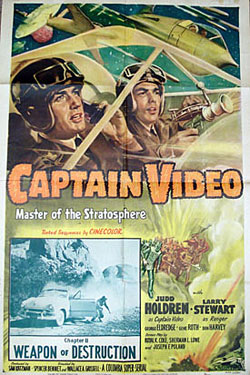 “Captain Video” “Captain Video”
by Boyd Magers
In Columbia’s 15 chapter “Captain Video” (Master of the Stratosphere)” (‘51) Judd Holdren as Captain Video, the commander of a worldwide network of scientific crime-fighting Rangers, pits his technical knowledge and courage against Vultura (Gene Roth) the cruel dictator of the planet Atoma who plans to conquer the solar system beginning with the peaceful planet Theros whose meek leader is Alpha (William Fawcett). Learning of Vultura’s plot for domination, Captain Video and his Video Ranger (Larry Stewart) journey to Theros (Vasquez Rocks) to aid Alpha, but back on Earth they are hindered in their interplanetary struggle by the brilliant but traitorous Dr. Tobor (George Eldredge) and his assistant Retner (Skelton Knaggs) who are secretly in league with Vultura.
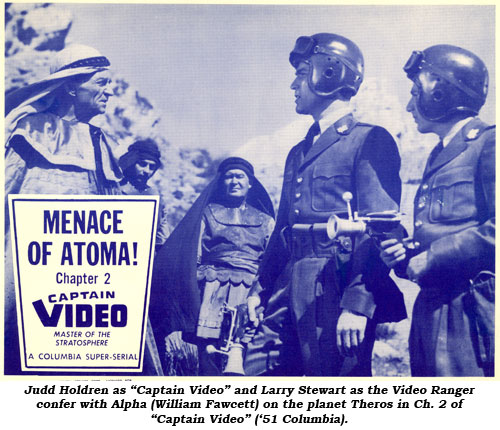
“Captain Video” was based on the lowbudget but popular Dumont network TV series (‘45-‘55). Brought to the serial screen by producer Sam Katzman and written by old hands Royal Cole, Joseph Poland, Sherman Lowe and George Plympton, the serial was a huge hit at the time—and the only serial ever to employ tinted color sequences by Cinecolor when on the planet Atoma (red) or Theros (green) in Ch. 1, 2, 3, 5, 6, 7, 8, 12, 13, 14, 15.
Captain Video and Ranger are constantly aided from their mountaintop lab by scientist Gallagher (Don Harvey) who often is there in the nick-of-time to neutralize any Vultura or Tobor threat simply by throwing a switch. Also, Captain Video and Ranger can rely on their Vibrator pistols or, like Batman, produce a hand held device from their utility belts. Captain Video’s jetmobile is a sleek and realistic car, possibly the serials most interesting scientific facet. It’s blown up in Ch. 3 but they have another “back in the garage”. Otherwise, there’s more scientific gear than in three “Flash Gordon” serials.
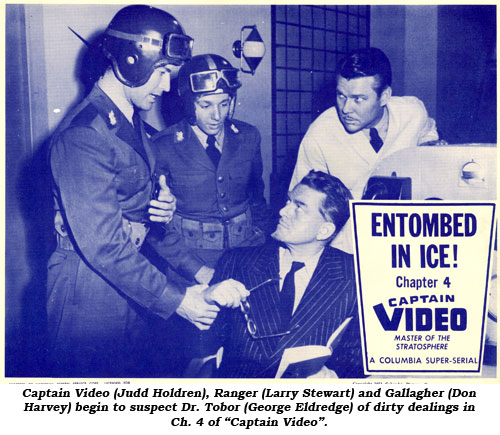
Directors Spencer Bennet and Wallace Grissell manage to keep the action moving from Earth to Theros to Atoma back and forth. “Captain Video” is certainly as wild and far-fetchedly implausible as any serial Katzman produced and it’s lively fun—but—the height of ludicrousness comes in Chapter 7 with an infamous bail-out from space into a haystack! And why did they think we wouldn’t notice whenever the spaceships take flight they’re cartoons instead of miniatures (which is what Republic would have done)? Also, did Katzman not realize we recognize Video’s headgear as a football helmet and a pair of goggles?
There’s plenty more to watch for—the robots from Gene Autry’s “Phantom Empire” in Chapter 3; the cartoon flying discs recycled from “Bruce Gentry” (‘49); costumes from previous Katzman sword and sandal epics and actual war film footage.
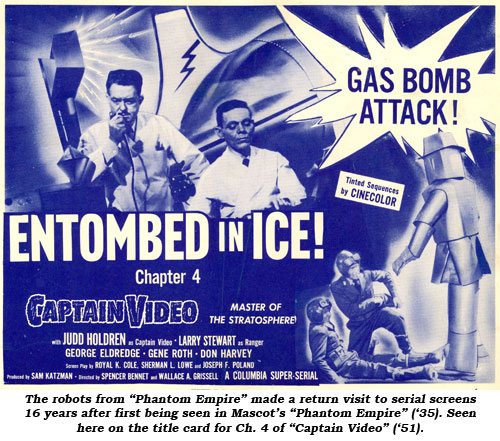
Helping to tie the serial to the TV series there are references in several chapters to Dr. Pauli, Captain Video’s TV nemesis.
Cast-wise, Judd Holdren is admirably dedicated and earnest, even when required to rattle off the serial’s techno-babble dialogue. Larry Stewart, who became a respected TV director/producer, handles his lines adequately. Gene Roth as Vultura struts around his planet Atoma lab, blasting out orders to his underlings, but is stymied by too much caped clothing and a set-bound performance. A dignified George Eldredge and smarmy Skelton Knaggs play their villainous roles to the hilt. Others in the cast include Jack Ingram as the leader of a group of Earth henchmen in various chapters (Katzman regulars Rusty Wescoatt, Zon Murray, Lee Roberts, Frank Matts, Frank Ellis, Frank Hagney, George Robotham, Wally West) that periodically carry out Dr. Tobor’s instructions…but due to the interplanetary travels they are under used in this serial. Tommy Farrell (Ch. 2), Pierce Lyden (Ch. 4-5) and I. Stanford Jolley (Ch. 8) appear as followers of Vultura. Rick Vallin, Bruce Edwards and Terry Frost pop up here and there as other Video Rangers. Tris Coffin and Oliver Cross are in and out quite rapidly as kidnapped eminent scientists. The always reliable Selmer Jackson as Commissioner of Public Safety is in several latter chapters.
There are Boo Boos: In Ch. 5 Captain Video mentions a prior trip to the planet Atoma, but he’s never been there before. In Ch. 14, Ranger radios Gallagher at headquarters to “identify numerals 2-4-8” but when Gallagher explains to his assistant Ranger Rogers (Jimmy Stark) that the numeral sequence is a code for danger, he refers to them as 2-8-4.
The serial ends with a quite interesting speech from Captain Video, one that’s more relevant today than it was in 1951. “There’s never been any people in history that wouldn’t be free of a dictator if they could. If all men were free to live by majority rule and worship as they wished, the universe would never know war again.”
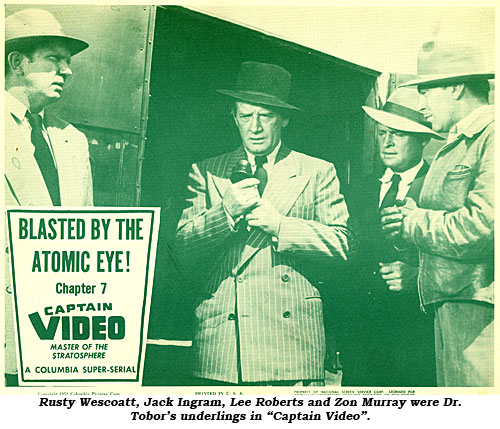
Video Ranger Larry Stewart Interviewed
In 1979 Greg Jackson Jr. interviewed Larry Stewart (1930-1997) in SERIAL WORLD (published by Jeff Walton) about his work in Sam Katzman serials. The following are excerpts about “Captain Video” from that interview.
GJ: Where were you born?
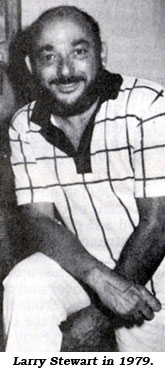 LS: Right here in Los Angeles. My real name was Sauber. I was a radio actor as a kid and that’s when I changed my name. I was Alvin Fuddle on “Blondie” and Egbert Gillis on “Life of Riley”. I did over 1,750 radio shows. I was the only kid on the West coast who did dialects; I did 39 of them—so I got all the jobs. Every time they needed somebody who could do dialects, it was me. LS: Right here in Los Angeles. My real name was Sauber. I was a radio actor as a kid and that’s when I changed my name. I was Alvin Fuddle on “Blondie” and Egbert Gillis on “Life of Riley”. I did over 1,750 radio shows. I was the only kid on the West coast who did dialects; I did 39 of them—so I got all the jobs. Every time they needed somebody who could do dialects, it was me.
GJ: Just how young were you when you started on radio?
LS: I was about seven. I came from a show business family. My uncle—we called him uncle but he really wasn’t—was Bert Gordon who played the Mad Russian on the Eddie Cantor radio show. He was a close friend of the family. I used to do an impression of him and one day I went to see the broadcast and I did it in front of Eddie Cantor. He thought it was so funny that he made me the Mad Russian Jr. and I appeared on some of those shows. I began to meet other people and went and read for parts—and got them. Then it was just one radio show after another for years and years. Finally I went into films.
GJ: I have a book that implies you got your role in “Captain Video” because your father was the casting director.
LS: That’s funny. My dad was not the casting director. He was with the company and casting was one of the things he did but he wasn’t just a casting director. No, I read for my part along with a bunch of other guys. I think what finally threw it over the top was having been a radio actor. I had developed a photographic memory and you know how thick serial scripts were. We used to do 102 set-ups a day which was a whole lot of shooting and I could memorize the script. When I came in to read for the part, I had memorized the entire serial and wherever they wanted me to read from, I just did it. Also I had been an AAU champion wrestler in my weight class in high school and in the Air Force. I had a brown belt in judo and I played football too. So I could do my own stunts. And with Sam, every stunt you could do yourself was a dollar saved with somebody else; he liked that a lot. So I jumped out of cars going 30 miles an hour and did my own fights with George Robotham and all those guys.
GJ: The character you played in “Captain Video” was simply called the Video Ranger.
LS: Yeah, I never had a first name. One day I came on the set and somebody had rewritten the name on the back of my chair and it said, “Saul Ranger.” They gave me a first name.
GJ: I have a photo of you as the Video Ranger and it looks like you’re wearing a football helmet.
LS: It is a football helmet with goggles and an Air Force uniform. In fact, that was my own Air Force uniform.
GJ: Couldn’t they get something more expensive that a football helmet? That looks cheap.
LS: You just said the key word. Cheap. That was the point though; to make money.
GJ: Judd Holdren played Captain Video.
LS: Judd managed a modeling agency for years. (Holden was only 58 when he died in 1974..-ed.)
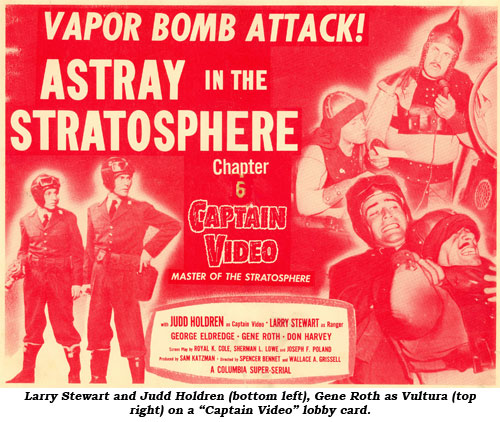
GJ: “Captain Video” was directed by Spencer G. Bennet and Wallace A. Grissell.
LS: I don’t remember too much about Wally. Spence was a man I dearly loved. He was not concerned particularly with drama but with action and getting the thing shot. I always knew I wanted to be a director from the time I was a radio actor. I had been directing in a little theater but Spence taught me the film technique. When I finished acting and went to work as a gofer for Sam for $53.40 a week, part of my job was as dialogue coach on the serials and Spence used to teach me about the camera: he would make me carry the 140 pound N. C. Mitchell camera. Spence believed a director should never ask anybody to do anything that he wouldn’t do. He was a dear guy. He had no sense of humor if it cost him time. Those of us on serials were always doing dumb things and playing around and having a good time and whenever it cost Spence some money, he got very upset.
GJ: Can you give me an example?
LS: Well, for instance, in “Captain Video” we had a thing called the Opticon Scillometer which had x-ray propensities and you could look at anything around the world or at any planet and see through it. One day the heavies were driving along in a truck with a big crate and we wanted to know what was in it. My line was, “I’ll look in the Opticon Scillometer and see if I can determine what’s in that box.” I looked into the thing during a take and there was a picture of a naked girl with her legs spread and I screamed. Spence shouted, “Cut! What are you doing? Playing around?” I said, “You’ve got to look in here.” Rick Vallin had rigged the picture on a string and when Spence walked over and looked in there, Rick pulled it up and there was nothing in there. Rick did that and also a couple of other really strange things.
GJ: Did you play any practical jokes on other people?
LS: I once dropped a bag of water from the scaffold on Crippler Karl Davis’ head in the middle of a scene and Spence almost killed me for that. Spence was a nice fellow but if you fooled around when you were working, he had no sense of humor at all. Spence had the most incredible memory I have ever come across. We would match a lot of stock footage—because it was cheaper—and Spence, who had directed from the day they hand cranked them, would look at a film clip from something he’d done 20 or 30 years ago and say, “Oh yes, that’s at Iverson’s Ranch and I’ll show you right where it is.” And he’d go right to the rock: that’s 20 or 30 years of memory. I remember once when I was sitting in Spence’s office, the phone rang and the guy said, “May I speak to Mr. Bennet, please. This is John Ford calling.” So I said, “Spence, this is some clown who says he’s John Ford.” And it was John Ford. He called to ask Spence how to shoot a trick shot. Spence and, I believe, his son-in-law, developed the optical printer. I guess Spence knew more about how to do live action optical effects than any other director in the business, he could put the star right in the middle of an explosion. When I became his dialogue coach, he taught me how to do it. Spence was just a super guy. He was the nattiest man you ever saw: white tennis shirts, pale slacks, tennis shoes or white loafers, and always that white straw hat he had. Everybody else on the set could be sweating, filthy, and dirty and Spence stood out like an ESQUIRE ad.
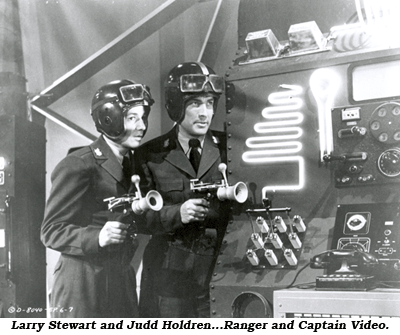
GJ: You had two directors on “Captain Video” so that you could film the serial quicker, didn’t you?
LS: Well, Spence was the first unit director and Wally Grissell was the second unit director. The second unit is mostly concerned with stunts, the run-bys, the fights, that kind of thing. Both units work in tandem at the same time. You would never have two units working at the same time in a studio but when you go on location, the principals would be here doing the dialogue scenes and three miles away would be Wally with the doubles doing the chases and this and that. Now when the time came that Wally had to cover a scene by having Judd or myself to the final fall into the closeup, they’d dump us into a car, drive us up to his unit, we’d jump out and he’d say, “Fall on the ‘X’.” Then we’d fall on the ‘X’ and he’d say, “Cut. Print.” They’d put us back into the car and send us back to the other unit. That’s how that worked. They didn’t do half and half.
GJ: Did Columbia ever consider starring the TV cast in the serial version?
LS: Not that I know of. I think the feeling was they were East Coast stage and television actors and the serial would be a film technique kind of thing. When you’re doing 102 setups a day, you want somebody who knows film to the point where he can work terribly quick. We knew, for instance, in the middle of a fight, if your hat came off, you restaged the fight while the camera was still rolling so you fell down on your hat again and got it on your head. They really wanted folks who were film indoctrinated at shooting terribly fast rather than try television actors who only did it on a stage and didn’t do any of the other stuff.
GJ: All the flying sequences in “Captain Video” were animated.
LS: Columbia had an animation department and their own lab. Animation wasn’t that big a deal. They didn’t have to farm it out, subcontract it, and send it to another lab. It could all be done at Columbia. Larry Butler was the head of the special effects department and the animation department was under him.
GJ: It’s interesting to note in “Captain Video” certain scenes were tinted. Scenes that took place on one planet were tinted red while scenes on another planet were tinted green.
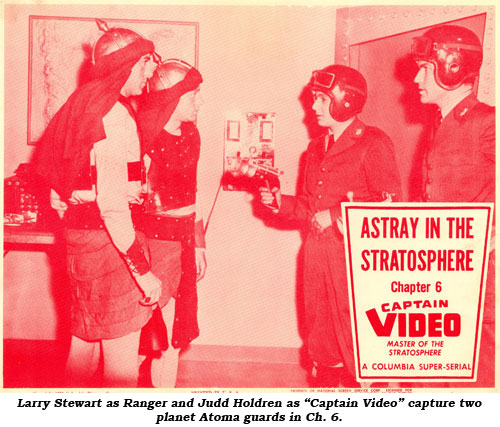
LS: Yes, “Captain Video” was tinted in Cinecolor. Some of the reason for that had to do with stock footage. You lost all your contrast with the old acetate film; you got no black and white; it was all gray. So to cover up the difference between new footage and old, they added a little color to it and it blended perfectly.
GJ: Again talking about saving money, it appears the so-called Electronic Men in “Captain Video” were wearing the robot suits from “The Phantom Empire”, the 1935 Mascot serial which starred Gene Autry.
LS:I’m sure Sam found those tin suits somewhere. Listen, Sam was the kind of guy that if we made a picture about a sheik in Arabia, he would say, “Okay, give me three more scripts. We got the sets.” So we’d repaint the sets and use them. Let’s say a major studio moved over onto the Sunset lot where we were and built a big, enormous cave. When they were finished with their picture and had gone away, Sam would say, “Leave the cave up.” Then we’d go out and write pictures for caves so we could use it. Once Sam told me, “I bought some stock film. See what we can come up with for this.” So I sat in the projection room and watched 100,000 feet of film about buffalo. I finally came up with Jim Bridger, who was the great buffalo scout and so we made a picture about him. We had Dennis Morgan riding up to a hill and looking off at 100,000 feet of stock buffalo film. Yeah, Sam resurrected everything he could resurrect and made a picture out of it. (“Gun That Won the West”, 1955.-ed.)
GJ: You said you did a lot of stunts yourself but did you have a stunt man at Columbia who used to double for you in more dangerous stunts?
LS: Yes, Teddy Manjean. He was about my height and weight and he used to double for me. If he was not available, Harvey Parry did.
GJ: Did you have any injuries in “Captain Video”?
LS: Yes, I remember three occasions. Once I was to run up to a car and the door was to fly open and knock me out. We had the door measured and had a wire on it. I was supposed to stop at a certain mark but there was gravel on the ground and I skidded right into the door and took it full in the mouth. Then another time a fellow by the name of Frank Matts hurt me. He was skinny and his knuckles were like knife blades. Somebody told him that you throw a stomach punch by hitting the stomach and then pulling. That’s the wrong way to do it. So when he threw the stomach punch, he went through my stomach and it felt like his fingers came out through my spine. Then on one other occasion I was doing a fight with George Robotham. He came up over a rock and jumped down. I took my swing but he slipped forward and I hit him full on the jaw and dislocated my wrist. I did the rest of my scene and ran off then Spence said, “Cut!” I came back to see if George was alright and he was fine and asked if I broke my wrist. But the point is you don’t stop; you keep going until the director says, “Cut!”
GJ: “Captain Video” reran in theatres into the ‘70s.
LS: (Laughs) You know, you always had weapons in serials but they were electronic guns or air guns or gas guns. Well, we had a vibrator gun in “Captain Video” that would wipe people out. In the first chapter I’m being attacked by a woman and Captain Video runs in and says, “Hold on, Ranger. I’ll take care of her with my vibrator!” And the whole theater just came apart because, of course, today it has a whole different connotation.
GJ: Is “Captain Video” or “Blackhawk” your favorite serial?
LS: Oh, I like “Captain Video” the most. I had a lot more happening to me in “Captain Video” and I was involved in most of the cliffhangers.
GJ: Have you any final comment?
LS: I wish some of the serials would come back. I think they were great kids’ entertainment for Saturday afternoons. There was a certain moral in all those serials: the good guys always beat the bad guys. The question of violence today drives me crazy.
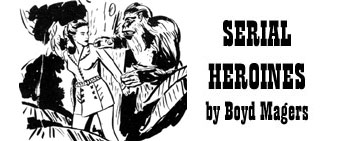
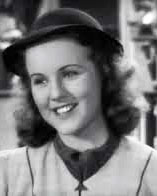 Vondell Darr, who encountered counterfeiters in a ghost town as well as a band of hostile lost Inca Indians living in the mountains, in Universal’s “Scouts to the Rescue” (‘39) serial which co-starred Jackie Cooper and Frank Coghlan Jr., had been a noted child actress in the ‘20s. Vondell Darr, who encountered counterfeiters in a ghost town as well as a band of hostile lost Inca Indians living in the mountains, in Universal’s “Scouts to the Rescue” (‘39) serial which co-starred Jackie Cooper and Frank Coghlan Jr., had been a noted child actress in the ‘20s.
Born in L.A. April 18, 1919, she made her film debut at four years old as Baby Molly in “The City That Never Sleeps” with Louise Dresser and Ricardo Cortez in 1924. Known for her golden curls she made her stage debut at seven in a production of “The Little Rebel” starring William and Dustin Farnum. In the mid ‘20s she co-starred with Jack Perrin in “Border Vengeance” and “Pony
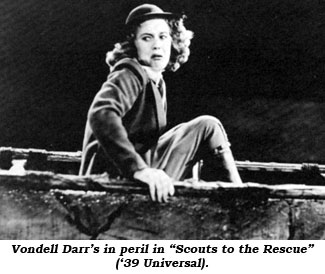 Express” with Ricardo Cortez (both ‘25). Heralded as “an amazing child actress” she was in major films such as “Sunrise” (‘27) w/George O’Brien and “Mother Machree” (‘28). However, after two films in ‘29 at age 10, she disappeared from the screen until 1938. After studying at Holmby School for Girls and graduating from Beverly Hills High School she landed the role in “Scouts to the Rescue”. Perhaps thanks to friend Mickey Rooney she was signed to MGM but only managed bit roles, mostly in Rooney’s films. Express” with Ricardo Cortez (both ‘25). Heralded as “an amazing child actress” she was in major films such as “Sunrise” (‘27) w/George O’Brien and “Mother Machree” (‘28). However, after two films in ‘29 at age 10, she disappeared from the screen until 1938. After studying at Holmby School for Girls and graduating from Beverly Hills High School she landed the role in “Scouts to the Rescue”. Perhaps thanks to friend Mickey Rooney she was signed to MGM but only managed bit roles, mostly in Rooney’s films.
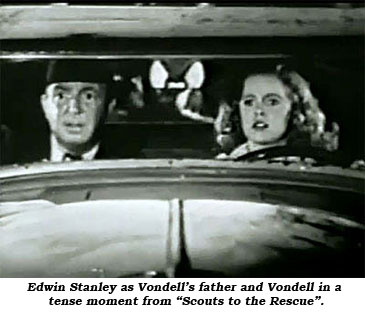 According to Frank Coghlan Jr. a year or so after making the serial some thug hit her on the head with a two-by-four and raped her right on the sidewalk near her home. She never resumed her acting career. In 1941 Darr graduated from UCLA and a month later married Navy officer Fred C. Wilson whom she’d known since they were 15. They were married until his death in 2006. At 93, Darr died September 10, 2012 in L.A. (Thanx in part to Laura Wagner.) According to Frank Coghlan Jr. a year or so after making the serial some thug hit her on the head with a two-by-four and raped her right on the sidewalk near her home. She never resumed her acting career. In 1941 Darr graduated from UCLA and a month later married Navy officer Fred C. Wilson whom she’d known since they were 15. They were married until his death in 2006. At 93, Darr died September 10, 2012 in L.A. (Thanx in part to Laura Wagner.)
Silent Serial Heroines (Part 2)
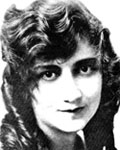 MARY FULLER starred in “What Happened to Mary” (‘12 Edison), “Who will Marry Mary” (‘13 Edison), “The Active Life of Dolly of the Dailies” (‘14 Edison). (left) MARY FULLER starred in “What Happened to Mary” (‘12 Edison), “Who will Marry Mary” (‘13 Edison), “The Active Life of Dolly of the Dailies” (‘14 Edison). (left)
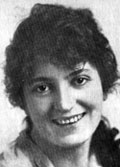 HELEN HOLMES starred in “The Girl and the Game” (‘15 Signal/Mutual), “A Lass of the Lumberlands” (‘16 Signal/Mutual), “Railroad Raiders” (‘17 Signal/Mutual), “The Fatal Fortune” (‘19 SLK), ) “The Tiger Band” (‘19 Holmes Prod./WB), “Battling Brewster” (‘24 Rayart), “The Riddle Rider” (‘24 Universal). (right) HELEN HOLMES starred in “The Girl and the Game” (‘15 Signal/Mutual), “A Lass of the Lumberlands” (‘16 Signal/Mutual), “Railroad Raiders” (‘17 Signal/Mutual), “The Fatal Fortune” (‘19 SLK), ) “The Tiger Band” (‘19 Holmes Prod./WB), “Battling Brewster” (‘24 Rayart), “The Riddle Rider” (‘24 Universal). (right)
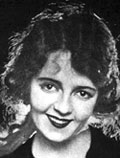 EILEEN SEDGWICK starred in “Lure of the Circus” (‘18 Universal), “The Great Radium Mystery” (‘19 Universal), “The Terror Trail” (‘21 Universal), “In the Days of Daniel Boone” (‘23 Universal), “The Riddle Rider” (‘24 Universal), “The Spider Net” (‘26 Goodwill, composed of footage from Sedgwick two-reelers), “Strings of Steel” (‘26 Universal), “Vanishing West” (‘28 Mascot). (left) EILEEN SEDGWICK starred in “Lure of the Circus” (‘18 Universal), “The Great Radium Mystery” (‘19 Universal), “The Terror Trail” (‘21 Universal), “In the Days of Daniel Boone” (‘23 Universal), “The Riddle Rider” (‘24 Universal), “The Spider Net” (‘26 Goodwill, composed of footage from Sedgwick two-reelers), “Strings of Steel” (‘26 Universal), “Vanishing West” (‘28 Mascot). (left)
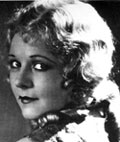 ALLENE RAY starred in “Ten Scars Make a Man” (‘24 Pathé) , “Way of a Man” (‘24 Pathé), “The Green Archer” (‘25 Pathé), “Play Ball” (‘25 Pathé), “Sunken Silver” (‘25 Pathé), “House Without a Key” (‘26 Pathé), “Melting Millions” (‘27 Pathé), “Hawk of the Hills” (‘27 Pathé), “Man Without a Face” (‘27 Pathé), “The Terrible People” (‘28 Pathé), “The Yellow Cameo” (‘28 Pathé), “The Black Book” (‘29 Pathé). (right) ALLENE RAY starred in “Ten Scars Make a Man” (‘24 Pathé) , “Way of a Man” (‘24 Pathé), “The Green Archer” (‘25 Pathé), “Play Ball” (‘25 Pathé), “Sunken Silver” (‘25 Pathé), “House Without a Key” (‘26 Pathé), “Melting Millions” (‘27 Pathé), “Hawk of the Hills” (‘27 Pathé), “Man Without a Face” (‘27 Pathé), “The Terrible People” (‘28 Pathé), “The Yellow Cameo” (‘28 Pathé), “The Black Book” (‘29 Pathé). (right)
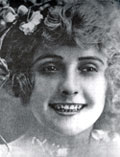 PEARL WHITE starred in “Exploits of Elaine” (‘14 Pathé), “Perils of Pauline” (‘14 Pathé), “The Romance of Elaine” (‘15 Pathé), “New Exploits of Elaine” (‘15 Pathé), “Iron Claw” (‘16 Pathé), “Pearl of the Army” (‘16 Pathé), “The Fatal Ring” (‘17 Pathé), “House of Hate” (‘18 Pathé), “The Black Secret” (‘19 Pathé), “The Lightning Raider” (‘19 Pathé), “Plunder” (‘23 Pathé). (left) PEARL WHITE starred in “Exploits of Elaine” (‘14 Pathé), “Perils of Pauline” (‘14 Pathé), “The Romance of Elaine” (‘15 Pathé), “New Exploits of Elaine” (‘15 Pathé), “Iron Claw” (‘16 Pathé), “Pearl of the Army” (‘16 Pathé), “The Fatal Ring” (‘17 Pathé), “House of Hate” (‘18 Pathé), “The Black Secret” (‘19 Pathé), “The Lightning Raider” (‘19 Pathé), “Plunder” (‘23 Pathé). (left)
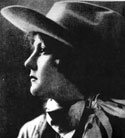 ANN (ANNA) LITTLE starred in “The Black Box” (‘15 Universal), “Lightning Bryce” (‘19 Arrow), “The Blue Fox” (‘21 Arrow), “Nan of the North” (‘22 Arrow), “The Eagle’s Talons” (‘23 Universal), “Secret Service Saunders” (‘25 Rayart). (right) ANN (ANNA) LITTLE starred in “The Black Box” (‘15 Universal), “Lightning Bryce” (‘19 Arrow), “The Blue Fox” (‘21 Arrow), “Nan of the North” (‘22 Arrow), “The Eagle’s Talons” (‘23 Universal), “Secret Service Saunders” (‘25 Rayart). (right)
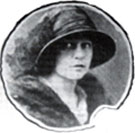 NEVA GERBER starred in “Mystery Ship” (‘17 Universal), “Voice on the Wire” (‘17 Universal), “Trail of the Octopus” (‘19 Hallmark), “The Branded Four” (‘20 Select), “The Screaming Shadow” (‘20 Hallmark), “The Mysterious Pearl” (‘21 Photoplay), “Santa Fe Trail” (‘23 Arrow), “Days of 49” (‘24 Arrow), “The Mystery Box” (‘26 Davis), “Officer 444” (‘26 Davis), “The Power God” (‘26 Davis), “Voice from the Sky” (‘30 G.Y.B.) (used Jean Dolores name). (left) NEVA GERBER starred in “Mystery Ship” (‘17 Universal), “Voice on the Wire” (‘17 Universal), “Trail of the Octopus” (‘19 Hallmark), “The Branded Four” (‘20 Select), “The Screaming Shadow” (‘20 Hallmark), “The Mysterious Pearl” (‘21 Photoplay), “Santa Fe Trail” (‘23 Arrow), “Days of 49” (‘24 Arrow), “The Mystery Box” (‘26 Davis), “Officer 444” (‘26 Davis), “The Power God” (‘26 Davis), “Voice from the Sky” (‘30 G.Y.B.) (used Jean Dolores name). (left)
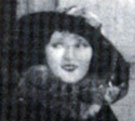 CARMEL MYERS starred in “Breaking Through” (‘21 Vitagraph). (right) CARMEL MYERS starred in “Breaking Through” (‘21 Vitagraph). (right)
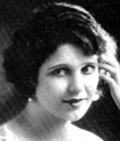 EUGENIA GILBERT starred in “The Crimson Flash” (‘27 Pathé), “Perils of the Jungle” (‘27 Weiss Bros./Artclass), “The Mysterious Airman” (‘28 Weiss Bros./Artclass), “Police Reporter” (‘28 Weiss Bros./Artclass). (left) EUGENIA GILBERT starred in “The Crimson Flash” (‘27 Pathé), “Perils of the Jungle” (‘27 Weiss Bros./Artclass), “The Mysterious Airman” (‘28 Weiss Bros./Artclass), “Police Reporter” (‘28 Weiss Bros./Artclass). (left)
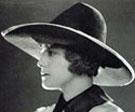 JOSIE SEDGWICK starred in “Daredevil Jack” (‘20 Pathé), “Double Adventure” (‘21 Pathé). (right) JOSIE SEDGWICK starred in “Daredevil Jack” (‘20 Pathé), “Double Adventure” (‘21 Pathé). (right)
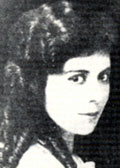 LOTTIE PICKFORD starred in “The Diamond From the Sky” (‘15 American). (left) LOTTIE PICKFORD starred in “The Diamond From the Sky” (‘15 American). (left)
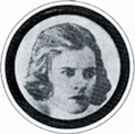 MARIE WALCAMP starred in “Liberty (A Daughter of the U.S.A.)” (‘16 Universal), “The Red Ace” (‘17 Universal), “The Lion’s Claws” (‘18 Universal), “Cyclone Smith” (‘19 Universal), “The Red Glove” (‘19 Universal), “The Dragon’s Net” (‘20 Universal). (left) MARIE WALCAMP starred in “Liberty (A Daughter of the U.S.A.)” (‘16 Universal), “The Red Ace” (‘17 Universal), “The Lion’s Claws” (‘18 Universal), “Cyclone Smith” (‘19 Universal), “The Red Glove” (‘19 Universal), “The Dragon’s Net” (‘20 Universal). (left)
top of page
|

